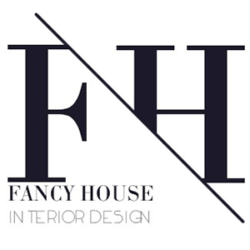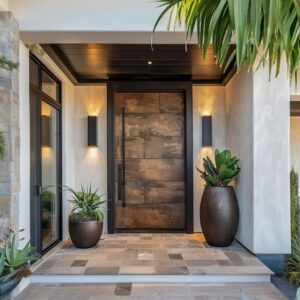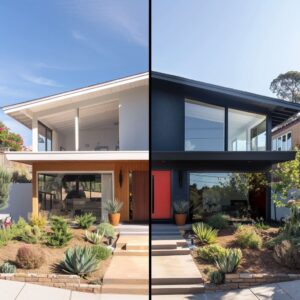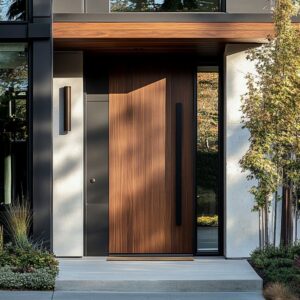Yellow front doors are having a moment, but not in the way most people think. This color choice goes far beyond adding a pop of brightness.
The designs reveal thoughtful decisions about color balance, material pairings, geometry, and lighting. In this article, we’re taking a close look at some standout yellow front door ideas, exploring details that often go unnoticed.
Whether it’s the way different finishes play with sunlight or how textures can add depth, these examples show that a front door can be both welcoming and architecturally striking. We’ll explore how color choices connect with their surroundings, how materials interact, and how lighting changes everything from morning to night.
Color Nuance and Psychological Impressions
Spectrum of Yellow Tones
The color of a front door can instantly shape first impressions. As noted by Homes & Gardens, yellow front doors often suggest warmth, optimism, and a welcoming feel—qualities that many homeowners want to convey right from the entrance.
Not all yellows are created equal, and these front doors prove it. Some lean into deep goldenrod shades that carry a warm, grounded presence, while others go bright with sunflower or buttercup yellows that feel cheerful and bold.
A marigold yellow, for instance, brings a slightly muted, earthy tone that works well with rustic homes or properties in more mountainous areas. You’ll often spot these softer shades in places like Tahoe or Aspen-inspired designs.
On the other hand, high-gloss lemon yellow finishes are common in mid-century modern homes and contemporary styles, especially in sun-soaked regions where bold color stands out against minimalist facades.
Day vs Night Shifts
The finish of a door plays a huge role in how it looks throughout the day. Matte and satin finishes absorb light, giving the color a soft, understated look during the day.
As evening sets in, many of these doors feature integrated LED lighting that highlights grain patterns or metallic inlays, adding warmth and dimension after dark. High-gloss surfaces take it a step further by reflecting the changing light, making the yellow appear more vivid, sometimes even golden, as the sun moves across the sky.
These subtle shifts give the entrance a dynamic quality, making it feel different depending on the time of day.
Subtle Reveal of Wood Grain or Texture
There’s a tactile quality to many of these yellow doors that’s easy to overlook. Thin layers of paint, or finishes that are lightly sanded back at the edges, allow the wood’s natural texture to peek through.
Reclaimed or live-sawn wood often brings an organic vibe that balances the modern lines of the door’s design. The faint visibility of wood grain softens the brightness of the yellow, making it feel grounded and natural rather than overly polished.
This attention to texture gives each door a handmade look, adding character without relying on excessive ornamentation.
Contrasts in Materials and Finishes
Metal Inlays as Functional Ornament
One of the standout features in these yellow doors is the creative use of metal inlays. Materials like brass, bronze, blackened steel, aluminum, and zinc aren’t just there for looks—they often serve as protective bands while adding another layer of style.
Many designs use these metals in clean vertical or horizontal lines, giving the door a structured, architectural quality. Some metals, like blackened steel or weathered zinc, bring a cooler tone that contrasts sharply against warm yellow paint.
Others, like brushed brass or aged bronze, feel right at home with a golden hue, their soft glow picking up the warmth and adding depth.
What makes these inlays more than a surface accent is the fine detailing etched into them. You’ll see everything from delicate fan motifs to simplified chevron patterns, nodding to design movements like Art Deco and mid-century modern.
On a sunshine yellow front door, these engraved metal strips can create a subtle play of light and shadow, adding movement to an otherwise flat surface.
Textural Juxtaposition
There’s something interesting that happens when different textures meet. Several doors combine coarse-sawn wood, reclaimed timbers, or even hand-troweled plaster with sleek, polished metals.
It’s the contrast between rough and refined that draws the eye. A deeply brushed wood surface can feel raw and grounded, while an adjoining brushed aluminum strip keeps things modern and crisp.
These juxtapositions aren’t just about mixing materials—they bring tension and balance, reflecting both craftsmanship and contemporary design.
Historical and Stylistic Influence
A closer look at the detailing reveals inspiration pulled from different eras. Many yellow doors borrow cues from the early 20th century—particularly Art Deco—using symmetrical patterns like stepped rectangles or fan shapes engraved into brass or aluminum.
Other designs channel mid-century modern style, often through etched starburst motifs or geometric linework in steel panels. Farmhouse and craftsman influences show up, too, with hand-hammered metal house numbers, riveted hardware, and glasswork that feels artisanal rather than mass-produced.
All these references are seamlessly blended into the designs, resulting in entries that feel fresh while giving a quiet nod to tradition.
Glass Inserts and Visual Layers
Privacy vs Visibility
Glass inserts are often overlooked, but they play a big role in the overall design. Whether it’s reeded, seeded, frosted, or gradient-tinted, the glass choices here are about finding the balance between letting light in and keeping the interior private.
Slender vertical glass strips are a common feature, drawing the eye upward and enhancing the height of the door, while horizontal glass panels can stretch the door’s proportions, making it feel wider and more grounded. The way these windows are positioned and finished isn’t accidental—it’s all about reinforcing the lines of the home’s facade and adding rhythm to the front entrance.
Edges and Glow
Some of the more refined details are easy to miss during the day but come to life at night. Many of these glass inserts have edges that are sandblasted or acid-etched, softening the transition from glass to wood or metal.
Once backlit by subtle LEDs, these edges glow gently, casting a halo effect that gives the doorway a warm, welcoming quality after dark. This kind of lighting highlights craftsmanship without overpowering the overall look.
In some designs, glass is set within a band of bronze or steel, and the combination changes how the glass itself looks. For instance, glass framed by bronze can take on a subtle amber tone, tying it back to the yellow paint nearby.
These little details give the front door more character, making it a focal point that works in both daylight and evening conditions.
Door Integration with Facade and Landscaping
Transitions from Outside to Inside
A front door doesn’t stand alone—it’s part of a larger composition. The strongest designs make sure the yellow door connects visually and materially with the rest of the home.
For example, if the door features a blackened steel inlay, that same finish might appear on the canopy overhead or in the trim around nearby windows. This repetition creates a sense of continuity and makes the entryway feel intentional rather than isolated.
Homes with cedar siding or warm wood cladding can amplify the inviting tone of a yellow door, especially in styles common to coastal or rural areas. In contrast, clean white stucco or smooth concrete walls provide a bright, neutral backdrop that makes the yellow pop.
This balance between door and exterior creates a visual flow that draws attention without overwhelming the eye. The goal is for the entrance to feel like an integrated part of the home, not an afterthought.
Planters and Garden Elements
Landscaping around a yellow front door often extends the story started by the door itself. Planters crafted from corten steel, bronze, or concrete are common choices because they echo the materials used in the door’s detailing.
Whether they’re tall urns, simple cylinders, or geometric boxes, their shapes often mirror the door’s design lines, whether that’s the clean geometry of mid-century modern or the softer curves of Art Deco inspiration. For more real-life examples of how landscaping and architectural details work with a yellow front door, take a look at Houzz’s gallery of yellow front door entryways.
It’s a helpful source of inspiration, showing how planters, paths, and materials all work together to frame the entrance.
Plant selections tend to follow this logic too. Succulents, grasses, and sago palms are favored not only because they’re low-maintenance but also because their structural forms pair well with bold door colors.
Their greens contrast beautifully with yellow, whether it’s a soft butter tone or a brighter sunflower shade. Even the color and finish of the pots—whether matte black or patinated bronze—help reinforce the entryway’s design language.
Structural and Engineering Nuances
Pivot Hinges and Flush Mounts
Many of these yellow doors are more than eye-catching—they’re feats of engineering. Some use pivot hinges instead of traditional side hinges.
This creates a clean look that allows the door to swing open smoothly, giving it a modern edge. A flush mount, where the door sits even with the exterior wall, keeps lines crisp and uninterrupted, letting the materials and finishes take center stage.
Even with heavy woods and substantial metal details, thoughtful construction ensures these doors operate seamlessly. Details like aligning a steel inlay with the handle or hinge side aren’t just aesthetic—they’re about balance and weight distribution.
These small choices contribute to the overall function without sacrificing appearance.
Weathering and Patina
Time plays a role in many of these designs. Metals like blackened steel, raw zinc, and bronze are often left with finishes that age gracefully.
They’re sealed to protect against the elements but allowed to develop subtle changes over time—adding character without causing deterioration.
Paint finishes also have their own story. Chalk paints and milk paints are often chosen for farmhouse and rustic-style yellow doors because they can gently wear at the edges.
This gives a sense of authenticity and craftsmanship, reinforcing the handmade feel common in traditional or reclaimed material homes. Rather than looking worn out, these finishes add depth and history to the door’s appearance.
Stylistic Bridges and Cultural Context
Art Deco Inspirations
Some yellow front doors take their design cues straight from the golden age of Art Deco. Think of fanned motifs, parallel lines, and those unmistakable stepped patterns—subtle, but there for anyone paying attention.
These details often show up in brushed brass or aluminum inlays, bringing a layer of geometric precision to the door. Instead of overwhelming ornamentation, they’re pared down to fit today’s minimalist approach.
The result is a door that feels rooted in history but fresh enough for a modern home. Whether you’re seeing this in a streamlined house with crisp stucco walls or a property influenced by 1930s architecture, these little nods to Deco design bring a quiet sense of style.
Mid-Century Modern Influences
Mid-century modern style shows up in plenty of these doors too, especially in areas known for iconic homes from that era. A bold yellow color block, starburst etchings, and reeded glass panels are trademarks of this look.
These elements often appear in homes that celebrate the simplicity and open plans typical of mid-century design. Some doors offer plenty of inspiration for doors with this vibe.
A smooth sunflower yellow finish paired with brushed aluminum and geometric glass cutouts fits right in, maintaining a link to mid-century heritage while still feeling fresh.
Farmhouse and Rustic Adaptations
Yellow has always had a place in farmhouse tradition—welcoming, familiar, and full of warmth. What’s changed is the way it’s being applied.
Clean silhouettes, blackened steel details, and chalk-painted finishes bring that timeless appeal into the present. You’ll see reclaimed wood left with visible grain, sometimes lightly sanded to reveal the raw material beneath the sunshine yellow paint.
The effect is a blend of old and new: rustic at its core but modern in execution. This approach works well in rural homes as well as modern interpretations of farmhouse style found across the country.
Deeper Observations and Hidden Intent
Subtle Branding of the Home
For many homeowners and designers, the front door is more than an entrance—it’s a signature. The combination of color, materials, and thoughtful details creates a statement unique to each property.
Whether it’s the house numbers cut into a steel strip or a specific shade of yellow that ties in with the landscape, these doors quietly brand the home. They give visitors an instant sense of what to expect inside, whether that’s sleek modernism, rustic comfort, or a mix of both.
Artful Composition, Not Decoration Alone
The yellow front doors featured here go far beyond decoration. Every choice—from the paint finish to the etched lines in the metalwork—is part of an overall composition.
Texture, light, proportion, and material all work together, often echoing design details found throughout the rest of the home. A brushed aluminum inlay isn’t just a shiny accent; it plays a role in balancing the warmth of the yellow and adding structure to the design.
These doors are carefully crafted elements that connect function with style.
Sense of Invitation and Contrast
Yellow is naturally welcoming—it catches the eye and signals warmth. But pairing that friendly color with industrial details like raw steel, brushed aluminum, or textured glass gives the entry more depth.
The warmth of the color contrasts with the coolness of the materials, offering a balance between approachability and bold design. It’s this mix that makes the entrance stand out.
Comfort on one hand, confidence on the other.
Conclusion
A front door can do far more than provide an entry point. As seen in these yellow front door designs, it becomes a statement piece—one that speaks to the style of the home and the personality of those living there.
Whether it’s a soft marigold on a rustic farmhouse or a bold sunflower gloss on a mid-century modern exterior, color choices shape first impressions.
But it doesn’t stop with color. The thoughtful use of materials like brass, bronze, and blackened steel brings contrast and depth.
Subtle details—an engraved house number, a narrow glass panel with a custom texture, or a softly glowing backlight—carry surprising impact. These aren’t random embellishments; they are deliberate design decisions that create a cohesive look.
When materials, textures, and lighting are carefully balanced, the door doesn’t just blend into the facade—it anchors the design. And over time, as light changes throughout the day or seasons shift, these doors continue to offer something fresh to notice.
What might seem simple at first glance reveals layers of detail that connect with the wider architectural story of the home.






























